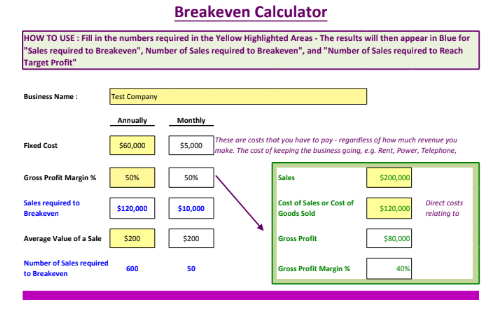Breakeven Point: Definition, Examples, and How to Calculate

It is essential in determining the minimum sales volume required to cover total costs and break even. Fixed costs are costs that do not change based on your production or sales volume (e.g., rent, insurance, and salaries). Variable costs are costs that fluctuate depending on how much you produce (e.g., raw materials, labor per unit). Simply enter your fixed business costs, your variable unit costs and your sales price to estimate the number of units you would need to sell to break even. You can also adjust price-points and recompute the needed sales volumes at different prices.
Break-Even Point in Units
The break-even point is calculated by dividing your fixed costs by the difference between the sales price per unit and the variable cost per unit. This tells you the number of units you need to sell to break even. Besides the cost of production, operational expenses are crucial for your business. But if you want to lower you BEP, it’s important to assess how much you’re spending on your operations.

Build a Better Business Plan.
For the longest time, asking for referrals is one effective way to grow a business. It allows you to expand your network based on customers who have been satisfied with your service. While you may assume regular clients spread a good word of mouth, it still pays to proactively ask for referrals. In research done by Amplifinity, they found that verbal referrals produced the best results with a 32% success rate.
Engineering Calculators
It enables them to sell at more competitive prices while maintaining the quality of their product and hitting profit margins. For small businesses, on average, it takes at least two to three years to become profitable. This is just a standard estimate, which means it varies depending on the type of product or service you are offering. Sometimes, a company can start earning right away, while others may take three years or longer to earn profits.
This margin indicates how much of each unit’s sales revenue contributes to covering fixed costs and generating profit once fixed costs are met. For example, if a product sells for $10 but only incurs $3 of variable costs per unit, the product has a contribution margin of $7. Note that a product’s contribution margin may change (i.e. it may become more or michael finkelstein author at the global treasurer less efficient to manufacture additional goods). The breakeven formula for a business provides a dollar figure that is needed to break even. This can be converted into units by calculating the contribution margin (unit sale price less variable costs). Dividing the fixed costs by the contribution margin will reveal how many units are needed to break even.
If you can find a local supplier that provides a good deal, that’s even better. And if you’ve been working with a supplier for a while, consider negotiating with them. Ask if there’s a way they can help reduce the price of your raw materials.
- Finally, the breakeven analysis often ignores qualitative factors such as market competition, customer satisfaction, and product quality.
- Lines of credit also usually come with adjustable interest rates, unlike fixed-rates on term loans or SBA loans.
- The algorithm does the rest for you – it automatically calculates your profit margin and markup, and your break-even point both in terms of units sold and cash revenue.
- So, your break even plan will form your datum point at which you become profitable.
Then, we’ll touch on strategies to reduce business costs, as well as different ways you can increase your sales. Another limitation is that the breakeven point assumes that sales prices, variable costs per unit, and total fixed costs remain constant, which is often not the case. The price of goods sold at fluctuates, and the cost of raw materials may hardly stay stable. In addition, changes to the relevant range may change, meaning fixed costs can even change. This makes it almost impossible to always have a most up-to-date, accurate breakeven point.
Let’s say you have a $20,000 commercial loan that you want to pay off in two years. To do this, you must put an additional $10 per unit if you intend to sell 2,000 products in two years. Thus, your BEP selling point will be $25 per product during the first two years. Suppose your overhead expense is $10 per product, which is $100,000 for 1,000 units. If you generate and sell 1,000 products, your total BEP would be $15,000, which is $15 per product. Our online calculators, converters, randomizers, and content are provided “as is”, free of charge, and without any warranty or guarantee.

